Garmin Canada 2021 LOW POWER TRANSMITTER (2400-2483.5 MHz) User Manual ANT Doc Title
DynaStream Innovations Inc. LOW POWER TRANSMITTER (2400-2483.5 MHz) ANT Doc Title
User Manual
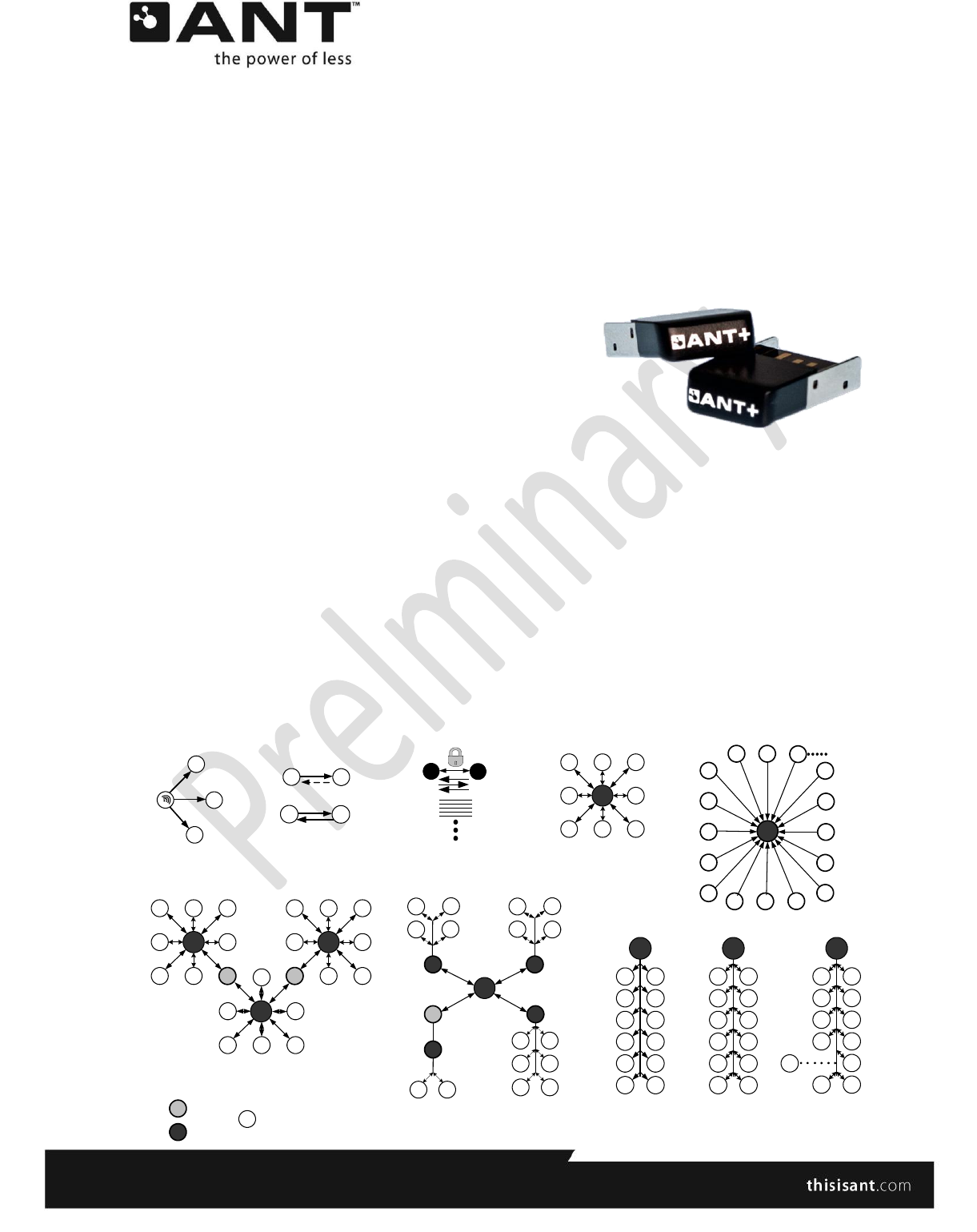
D00001513 Rev 0.95
ANTUSB-m Stick
FEATURES
78 selectable RF channels in 2403 to 2480MHz ISM band
ANT channel combined message rate up to 190Hz (8byte
data payload)
Minimum message rate per ANT channel 0.5Hz
Burst transfer rate up to 60Kbps (true data throughput)*
Up to 8 ANT channels
Up to 8 public, managed and/or private network keys*
Encrypted data channel*
High duty search and active search sharing *
WHQL certified Windows driver
No driver installation is required on Mac OS X machines
Support on device using Android 3.1 or later and having
USB host enabled
ANT library files for applications development
Supports USB 1.1/2.0 Full Speed specification with Type
A USB connector
Radio regulatory approval for major markets
-10°C to +50°C operating temperature
18.96 x 12.48 x 5.02 mm
RoHS compliant
* Enhancements in the new generation ANT core stack
ANT NETWORK CONFIGURATIONS
112
211
310
4 9
5 8
6 7
M
PEER
TO
PEER
STAR
PRACTICAL MESH
SHARED
BI-DIRECTIONAL
8 7 6
9
10
11
12
13
14 15 16
5
4
3
2
1
SCANNING MODE
ANT-FS
(Secure Authenticated)
112
211
310
4 9
?8
6 7
M
AD-HOC
AUTO
SHARED
112
211
310
4 9
5 8
6 7
M
SHARED
UNI-DIRECTIONAL
n
Bidirectional
Acknowledged
BROADCAST
SHARED CLUSTER
Sensor
Hub
Relay
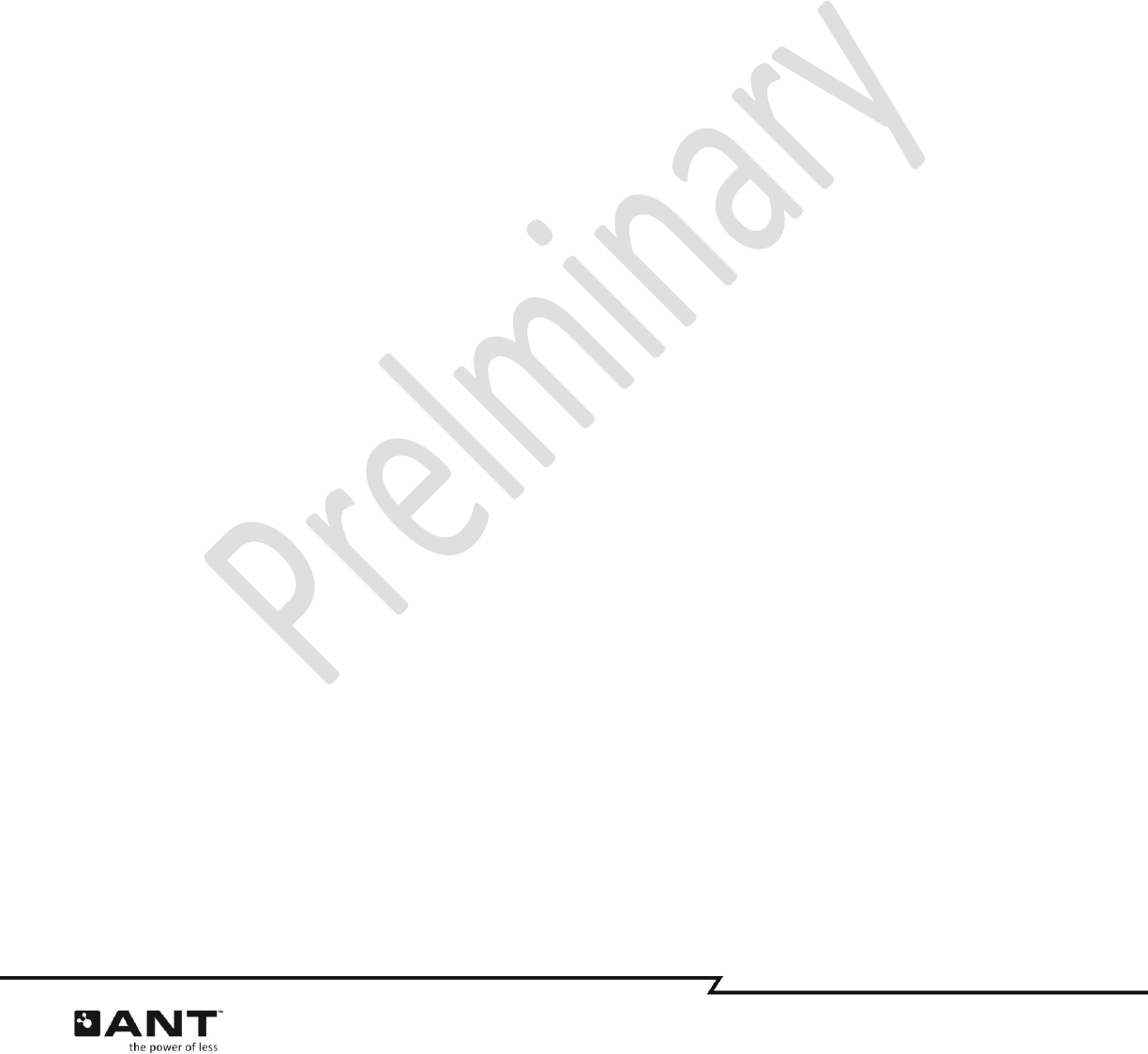
Page 2 of 14 ANTUSB-m Stick Datasheet
thisisant.com
Notices and Restricted Use Information
Information contained in this document is provided only for your ("Customer" or “you”) convenience and may be
superseded by updates. It is your responsibility to ensure that your application meets with your specifications.
Dynastream Innovations Inc. ("DYNASTREAM") makes no representations or warranties of any kind whether
express or implied, written or oral, statutory or otherwise, related to the information, including but not limited to
its condition, quality, performance, merchantability or fitness for purpose. DYNASTREAM disclaims all liability
arising from this information and its use.
DYNASTEAM does not assume any responsibility for the use of the described ANT product (“the product(s)”).
Dynastream makes no representation with respect to the adequacy of the product in low-power wireless data
communications applications or systems. Any Systems using the product must be designed so that a loss of
communications due to radio interference or otherwise will not endanger either people or property, and will not
cause the loss of valuable data. DYNASTREAM assumes no liability for the performance of products which are
designed or created using the products.
The products are not designed, intended, or authorized for use as components in systems intended for surgical
implant into the body, or other applications intended to support or sustain life, or for any other application in
which the failure of the product could create a situation where personal injury or death may occur. If you use the
products for such unintended and unauthorized applications, you do so at your own risk and you shall indemnify
and hold DYNASTREAM and its officers, employees, subsidiaries, affiliates, and distributors harmless against all
claims, costs, damages, and expenses, and reasonable attorney fees arising out of, directly or indirectly, any claim
of personal injury or death associated with such unintended or unauthorized use, even if such claim alleges that
DYNASTREAM was negligent regarding the design or manufacture of the Product.
The information disclosed herein is the exclusive property of DYNASTREAM, and is not to be reproduced and/or
distributed without the written consent of DYNASTREAM. No part of this publication may be reproduced or
transmitted in any form or by any means including electronic storage, reproduction, execution or transmission
without the prior written consent of DYNASTREAM. The recipient of this document by its retention and use agrees
to respect the security status of the information contained herein.
DYNASTREAM believes the information contained herein is correct and accurate at the time of its release.
However, the information contained in this document is subject to change without notice and should not be
construed as a commitment by DYNASTREAM unless such commitment is expressly given in a covering document.
© 2012 Dynastream Innovations Inc. All Rights Reserved. ANT is a registered trade mark of Dynastream
Innovations Inc.
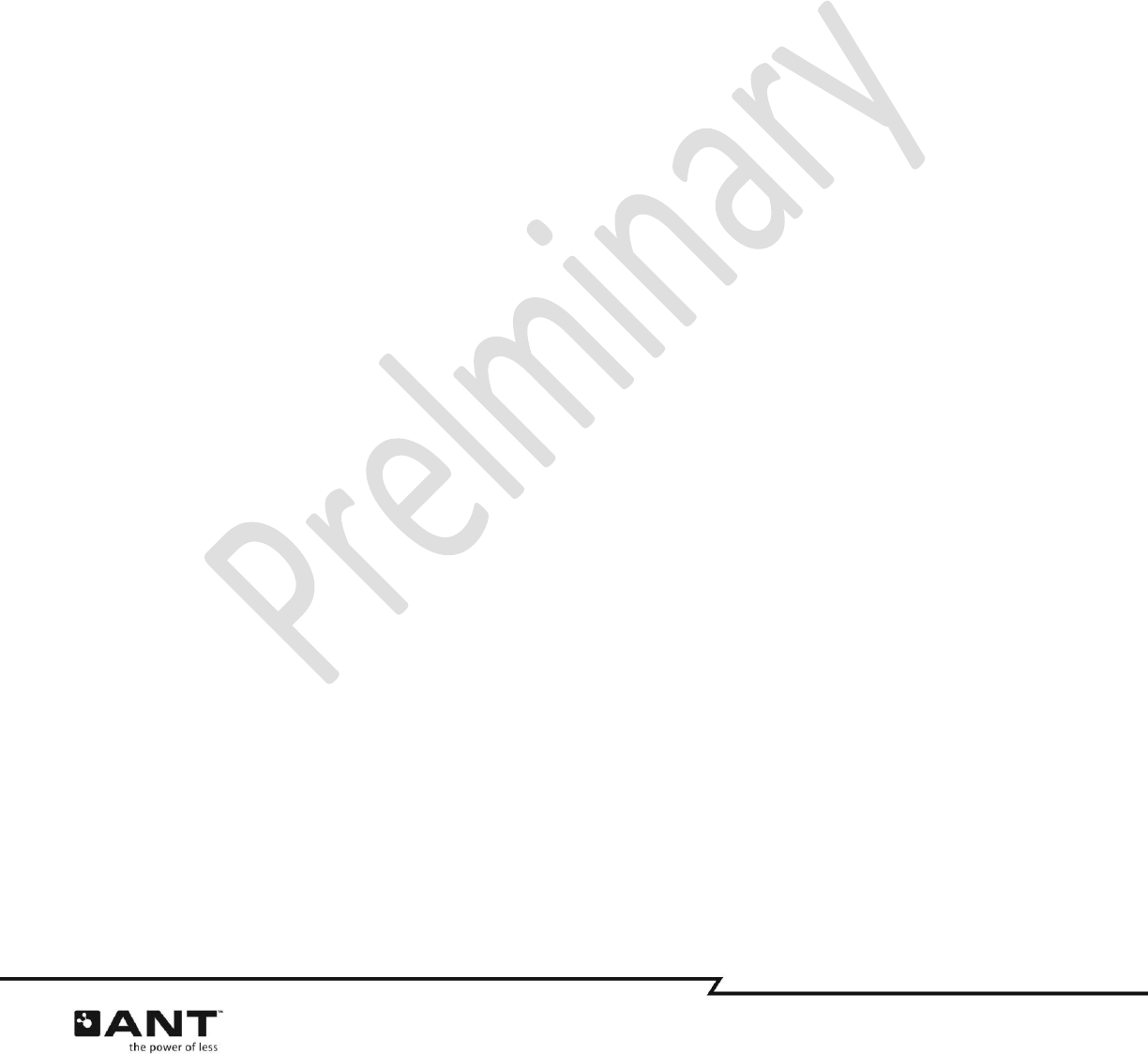
ANTUSB-m Stick Datasheet Page 3 of 14
thisisant.com
Table of Contents
1. ANTUSB-m ..................................................................................................................................................... 6
1.1 Drivers ........................................................................................................................................... 6
1.2 ANT library ..................................................................................................................................... 6
1.3 Product Model and Brand ................................................................................................................ 7
1.3.1 Top Logo Area .................................................................................................................. 7
1.3.2 Front Logo Area ................................................................................................................ 7
2. Regulatory Approval (not completed on the date of this document) ....................................................... 9
2.1 United States .................................................................................................................................. 9
2.2 Industry Canada Compliance ........................................................................................................... 9
2.3 CE Declaration of Conformity ........................................................................................................... 9
2.4 Japan ........................................................................................................................................... 10
2.5 Australia & New Zealand ............................................................................................................... 10
2.6 Russia .......................................................................................................................................... 10
2.7 China ........................................................................................................................................... 10
3. Specifications...............................................................................................................................................11
3.1 Mechanical ................................................................................................................................... 11
3.2 Environmental .............................................................................................................................. 11
3.3 Electrical ....................................................................................................................................... 11
3.4 RF Communications ...................................................................................................................... 11
4. Mechanical Drawings ..................................................................................................................................13
5. Support ........................................................................................................................................................14
5.1 ANT Forum ................................................................................................................................... 14
5.2 Public Technical References ........................................................................................................... 14
5.3 ANT Developer’s Zone ................................................................................................................... 14
5.4 ANT Social Networks ..................................................................................................................... 14

Page 4 of 14 ANTUSB-m Stick Datasheet
thisisant.com
ANT™ Overview
ANT™ is a practical wireless sensor network protocol running on 2.4 GHz ISM band. Designed for ultra low power,
ease of use, efficiency and scalability, ANT easily handles peer-to-peer, star, tree and practical mesh topologies.
ANT provides reliable data communications, flexible and adaptive network operation and cross-talk immunity. The
protocol stack of ANT is extremely compact, requiring minimal microcontroller resources and considerably reducing
system costs.
ANT provides carefree handling of the Physical, Network, and Transport OSI layers. In addition, it incorporates key
low-level security features that form the foundation for user-defined, sophisticated, network-security
implementations. ANT ensures adequate user control while considerably lightening computational burden in
providing a simple yet effective wireless networking solution.
ANT supports public, managed and private network architectures with 232 uniquely addressable devices possible,
ensuring that each device can be uniquely identified from each other in the same network.
ANT is proven with an installed base of over four million nodes in ultra low power sensor network applications in
sport, fitness, home and industrial automation. The ANT solutions are available in chips, chipsets and modules to
suit a wide variety of application needs.
Enhancements in this new generation ANT core stack:
Fast data burst up to 60 bps (true data throughput)
Encrypted data channel
Up to 8 ANT network keys
High duty search and active search sharing
The complete description of ANT message protocol is found in the document “ANT Message Protocol and Usage”.
The serial interface details are provided in the document “Interfacing with ANT General Purpose Chipsets and
Modules”. Both documents are available on www.thisisant.com.
ANT+ and ANT+ Alliance
ANT+ is the open application layer on the top of the ANT stack. It standardizes communications and facilitates
interoperability between a wide array of personal sports, wellness and lifestyle monitoring devices. ANT+ defines
device profiles that specify access, data formats, and channel parameters.
Application / Presentation
Layers
Higher Level Security
Network / Transport &
Low Level Security
Data Link Layer
Physical Layer
}Implemented
by ANT
}User Defined
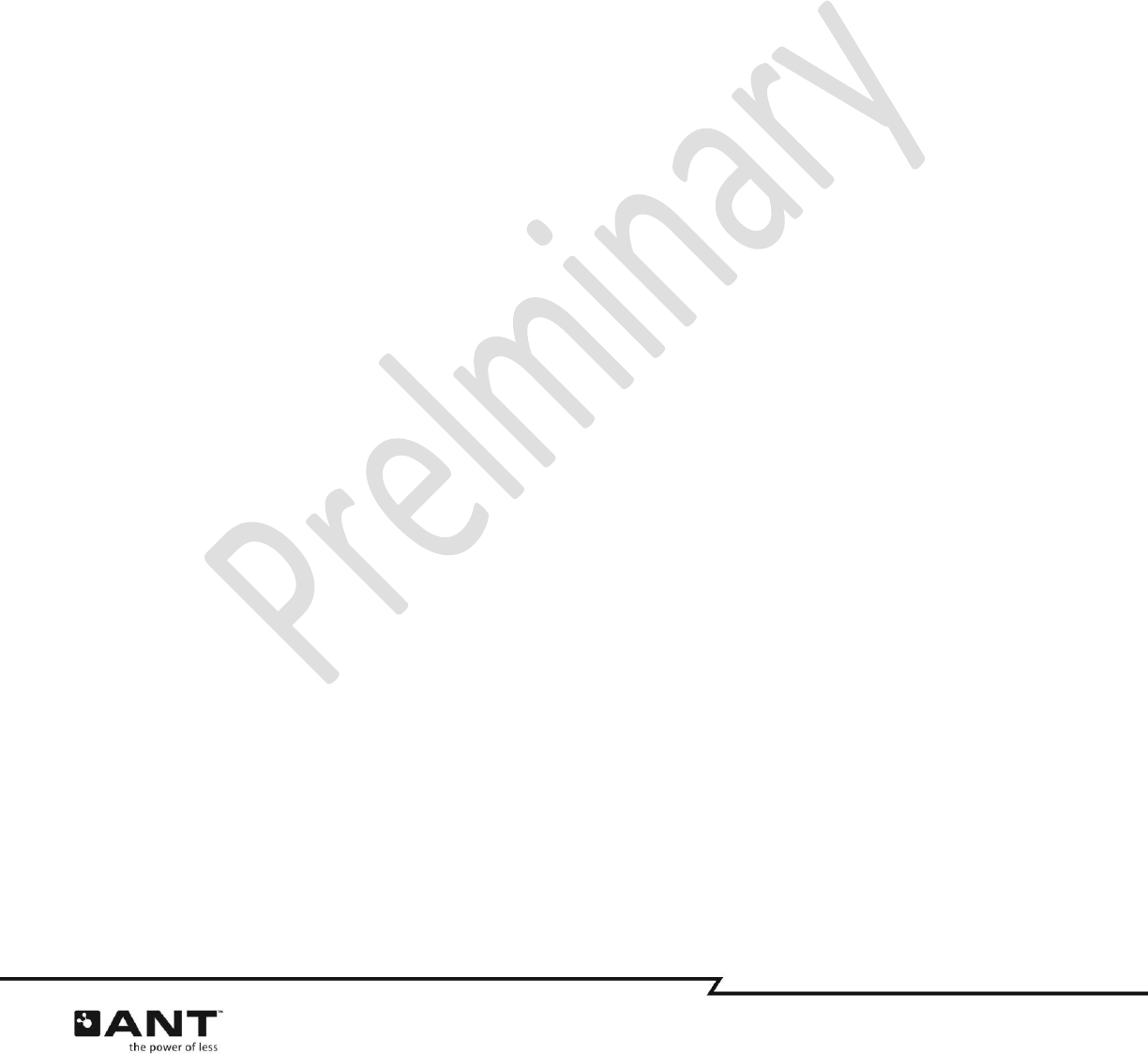
ANTUSB-m Stick Datasheet Page 5 of 14
thisisant.com
The ANT+ Alliance is comprised of companies who have adopted the ANT+ promise of interoperability. The
Alliance ensures standardized communication through optimized brand value and partnerships with other top tier
companies and products.
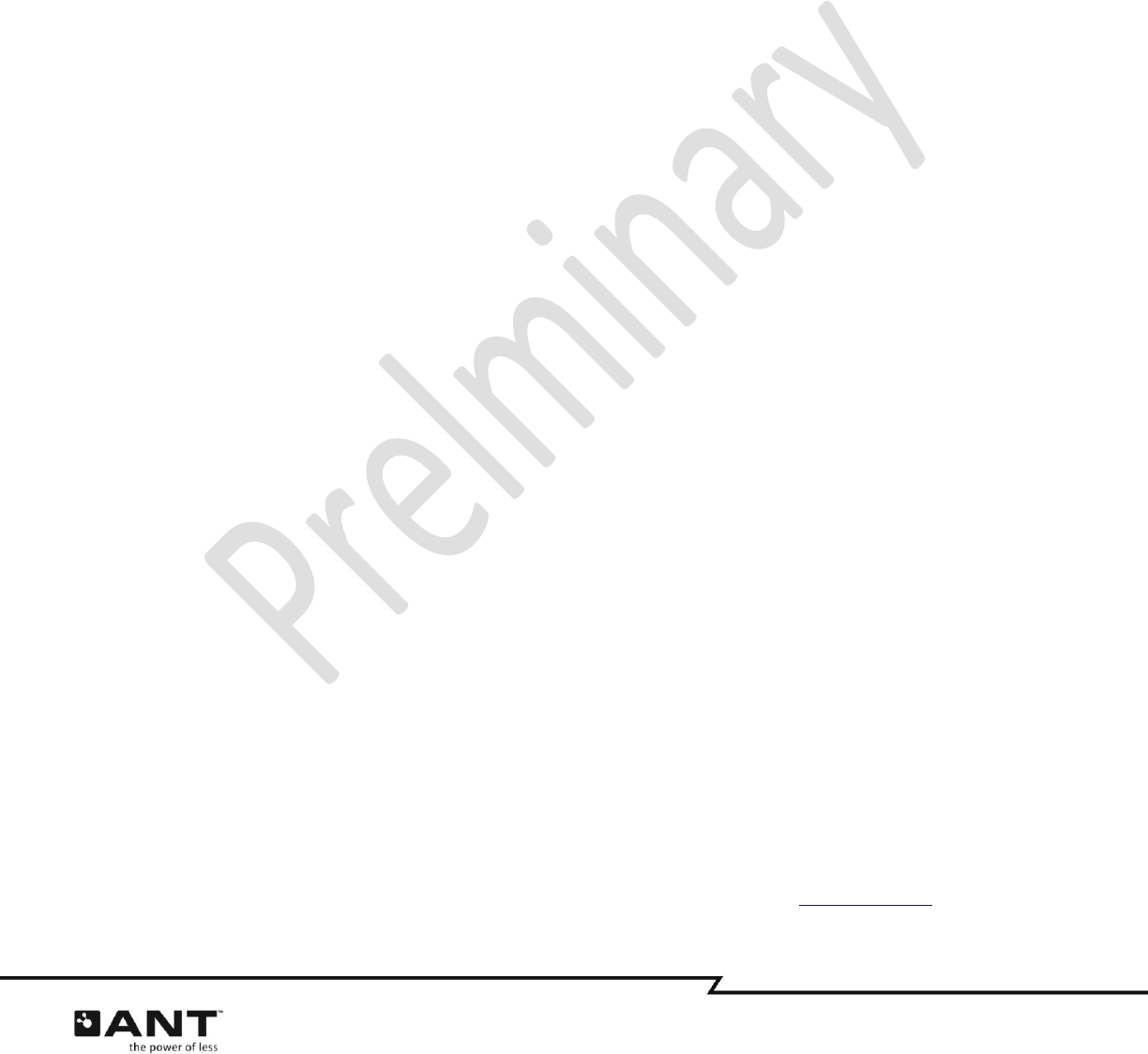
Page 6 of 14 ANTUSB-m Stick Datasheet
thisisant.com
1. ANTUSB-m
The ANTUSB-m is a USB dongle that provides a quick and easy solution for Windows PC, Mac and Android
equipment with an USB type A port to ANT wireless networks. Applications running on these computers or
equipment often perform as the hub node of a network through the ANT USB stick to receive, store, analyze and
display data collected from ANT sensors or other wearable or portable hub devices such as a watch and a bike
computer. The application may also serve as the gateway to the Internet for cloud computing. The ANTUSB-m is
a miniature design. When plugging in, the majority of the body is buried inside the computer or equipment.
The ANTUSB-m includes many new feature enhancements of ANT.
Fast data burst up to 60 kbps (true data throughput)
Encrypted data channel
Up to 8 ANT network keys
High duty search and active search sharing
These enhancements will deliver a better user experience on data downloading, private and secure data transfer,
and connectivity with multiple devices. For detailed description and usage of these ANT enhancements, as well as
of many other new features, please refer to “ANT Message Protocol and Usage”.
The ANTUSB-m offering is supported by a set of Windows, MAC and Android drivers and a software library that
provides application level interface to ANT functions. The accompanying software available from Dynastream
includes sample application code that dramatically reduce the time required for connecting a computer to an ANT
sensor network.
Operating in the globally available ISM radio frequency band of 2.4GHz, the ANTUSB-m stick conforms to
multinational RF regulatory standards, allowing the same product line to be sold and used in North America,
Europe, and Asia, without modification.
1.1 Drivers
Drivers are required for the ANTUSB-m
Windows XP, Vista, 7 and above
The Windows drivers have been WHQL (Windows Hardware Quality Labs) certified and listed on windows
updates. This allows the automatic driver install when the computer is connected to the internet, without
special configuration or UAC (User Account Control) prompts.
The driver is also available from www.thisisant.com.
Mac OS X10 and above
ANTUSB-m is designed to work with Apple’s I/O Kit framework. No additional driver installation is
required on Mac OS X machines.
Android 3.1 and above
The ANT USB Service is available from play.google.com for phones supporting USB Host feature.
1.2 ANT library
ANT library packages are provided for development in several languages, including C++ for Windows and Mac,
.Net library for Windows, and Java for Android. ANT library packages are accessible from www.thisisant.com upon
the acceptance of the ANT+ adopter agreement. The usage of the Windows and Mac OS X library package is
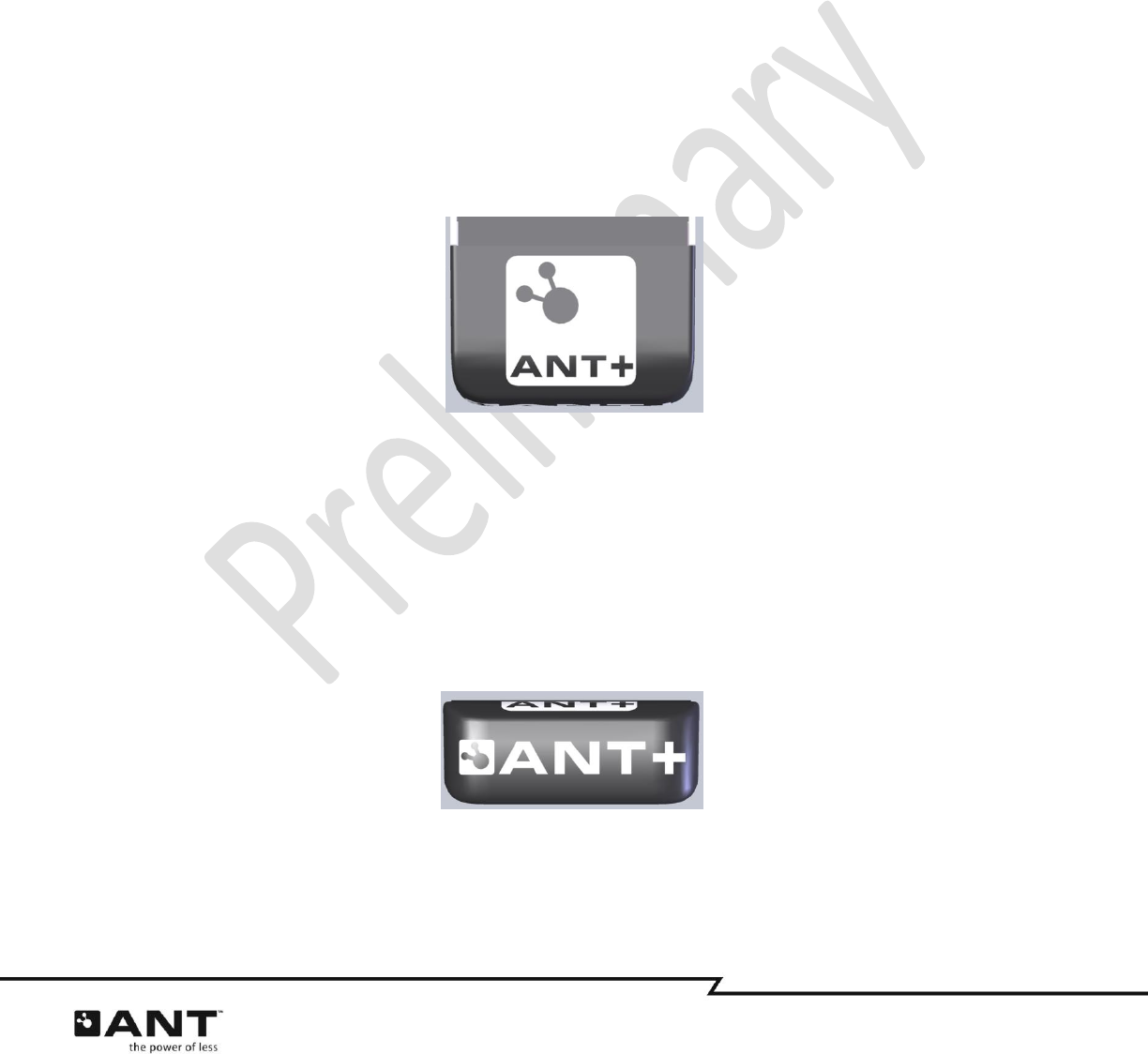
ANTUSB-m Stick Datasheet Page 7 of 14
thisisant.com
governed by ANT+ Shared Source License. The usage of the Android SDK package is governed by the Apache 2.0
license.
For detailed ANT feature description and message usage, please refer to “ANT Message Protocol and Usage”.
1.3 Product Model and Brand
The ANTUSB-m stick is released in black color, unbranded and with a special ANT+ figure mark on the front. The
top side is left blank for customers to print or apply a sticker of their own logos or brand names.
Dynastream offers product customization for volume customers at a cost. The customization includes the choice of
white color and logo or brand printing on top or front. Please contact Dynastream directly for such request.
1.3.1
Top Logo Area
The top logo area of the USB-m is one of the options for printing. The surface is curved near the end of the stick,
but any distortion of a flat image will be too small to make out under visual inspection
The dimensions for a logo are:
Width: 11mm
Height: 7.1mm for a flat image projected onto the surface (7.3mm after projecting)
Figure 1 Top Logo Area using ANT+ Logo for Illustration
The curvature of the surface is larger near the end of the ANTUSB-m. So this is the area where any stretching of
the image will occur.
The bottom corners do have a large fillet on them (approximately 1.9mm in radius). As such, any logos must take
this into account if it is desired to have the logo off center.
1.3.2
Front Logo Area
The end logo area is the second location available for branding. It is a gently curved surface facing directly out
when installed in a standard USB port.
Figure 2 Front Logo Area Using ANT+ Figure for Illustration
The dimensions for a logo are: 10.2mm x 3.5mm
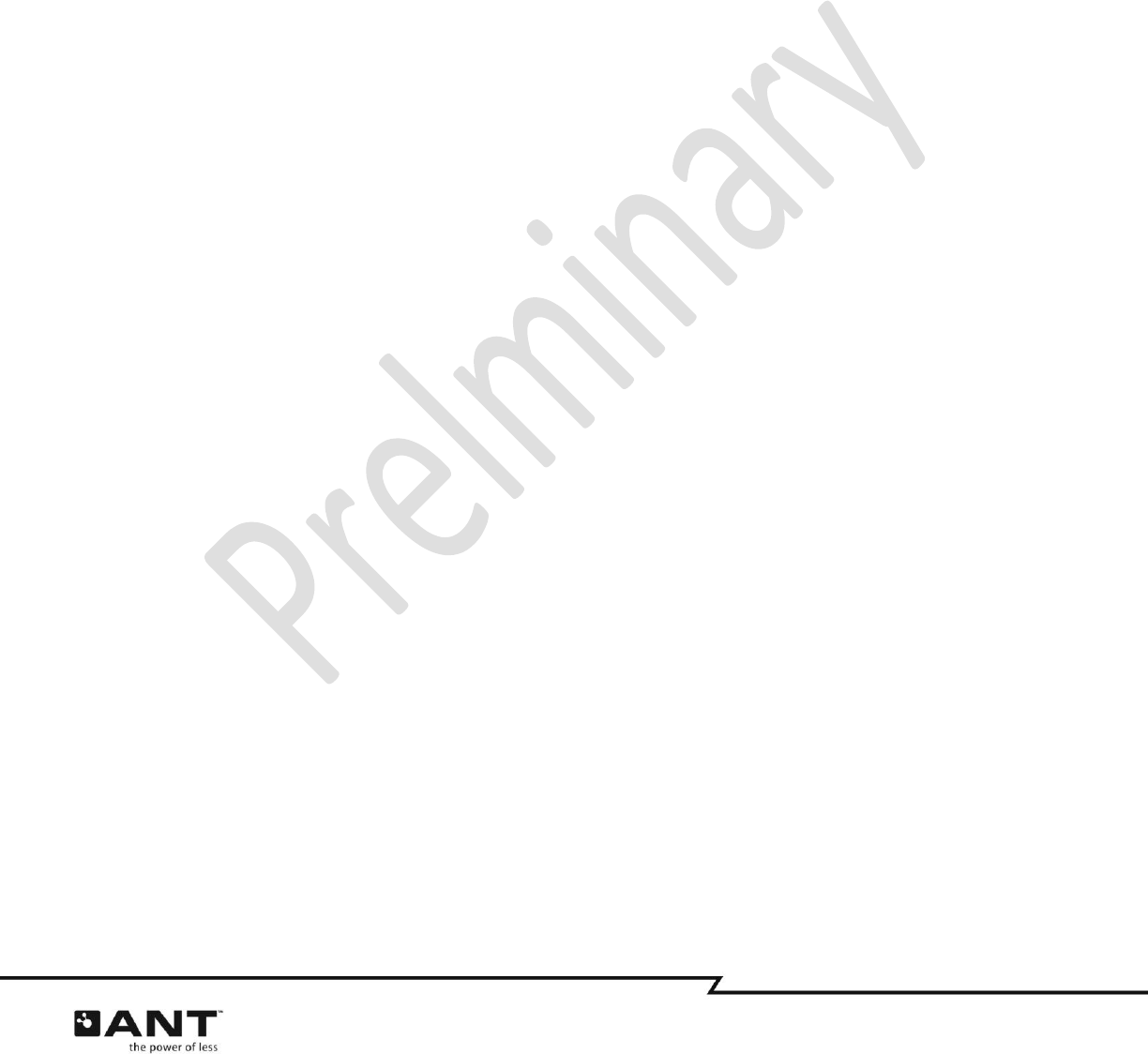
Page 8 of 14 ANTUSB-m Stick Datasheet
thisisant.com
The Fillets on the edge can cause some distortion to the image as they “curl away” from the
main printing location. This distortion will not be visible to the naked eye. As well, objects that
extend too far around the corner cannot be printed.
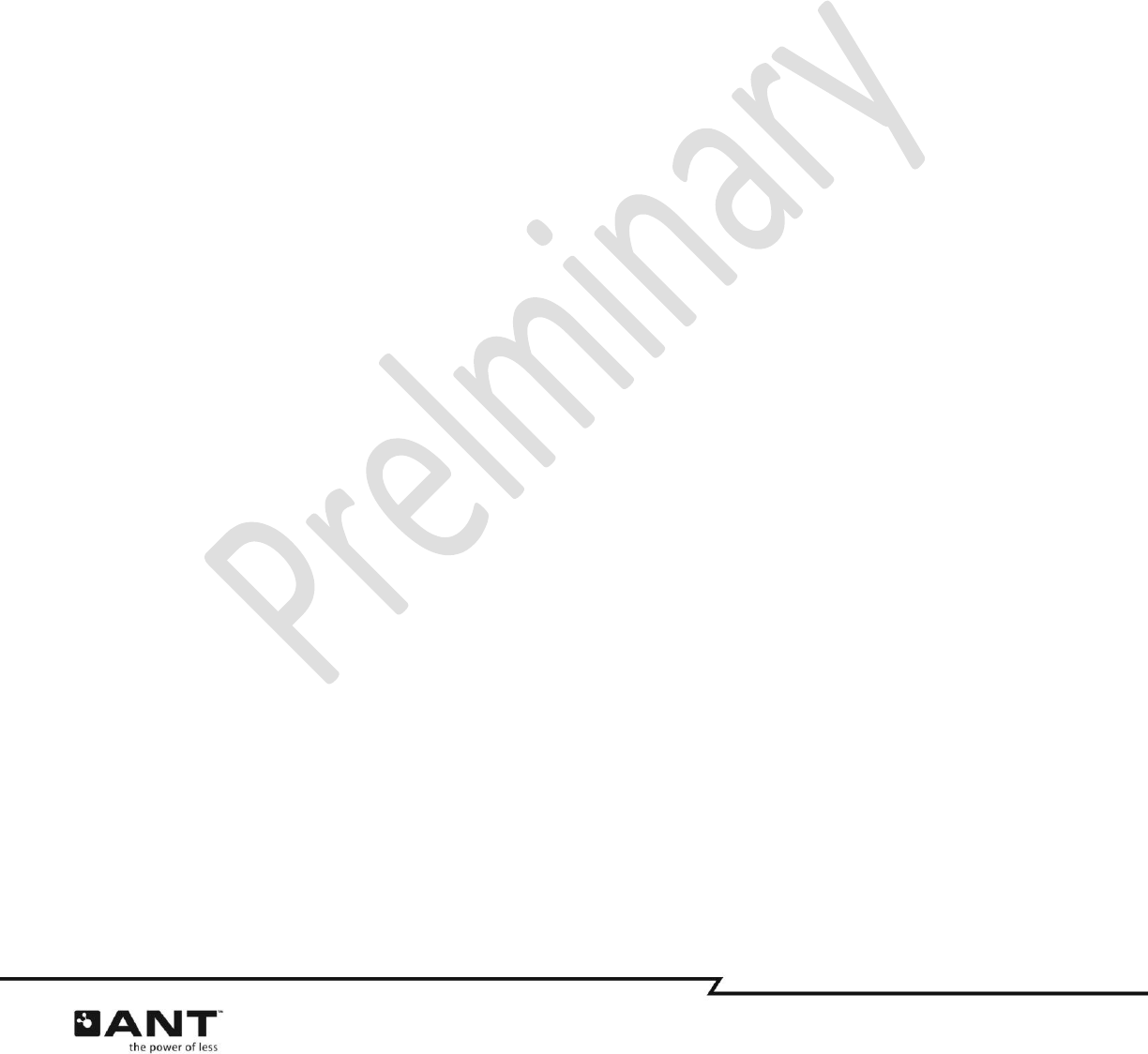
ANTUSB-m Stick Datasheet Page 9 of 14
thisisant.com
2. Regulatory Approval (not completed on the date of this document)
The ANTUSB-m has received regulatory approvals in the United States (FCC), Canada (IC), Europe (ETSI), Japan
(ARIB), Australia and New Zealand, China and Russia.
2.1 United States
The ANTUSB-m has been tested and found to comply with Part 15 of the FCC interference limits for Class B and
class C devices. Operation is subject to the following two (2) conditions: 1) This device may not cause harmful
interference and 2) This device must accept any interference received including interference that may cause
undesired operation.
This equipment generates, uses and can radiate radio frequency energy and may cause harmful interference to
radio communications if not installed and used in accordance with the instructions. However, there is no guarantee
that interference will not occur in a particular installation. If this equipment does cause harmful interference to
radio or television reception, which can be determined by turning the equipment off and on, the user is
encouraged to try to correct the interference by one of the following measures:
Reorient or relocate the receiving antenna.
Increase the separation between the equipment and the receiver.
Connect the equipment into an outlet that is on a different circuit from the receiver.
Consult the dealer or an experienced radio/TV technician for help.
This product does not contain any user-serviceable parts. Unauthorized repairs or modifications could result in
permanent damage to the equipment, and void your warranty and your authority to operate this device under Part
15 regulations.
The ANTUSB-m dongle is marked with “FCC ID: O6R2021” (note: First Character is the letter O, not the # 0.)
2.2 Industry Canada Compliance
The ANTUSB-m complies with Industry Canada licence-exempt RSS standard(s). Operation is subject to the
following two conditions: (1) this device may not cause interference, and (2) this device must accept any
interference, including interference that may cause undesired operation of the device.
(Le présent appareil est conforme aux CNR d'Industrie Canada applicables aux appareils radio exempts de licence.
L'exploitation est autorisée aux deux conditions suivantes : (1) l'appareil ne doit pas produire de brouillage, et (2)
l'utilisateur de l'appareil doit accepter tout brouillage radioélectrique subi, même si le brouillage est susceptible
d'en compromettre le fonctionnement.)
The ANTUSB-M dongle is marked with “IC: 3797A-2021”
2.3 CE Declaration of Conformity
The ANTUSB-m is declared to be in conformance with the essential requirements and other relevant provisions of
1999/5/EC and 2006/95/EC, as a low-powered unlicensed transmitter:
EN 60950-1:2006 Safety of Information Technology Equipment
EN 300 440-1 v1.4.1:2008, EN 300 440-2 v1.2.1:2008 Electromagnetic compatibility and Radio spectrum
Matters (ERM); Short range devices
EN 301 489-3 v1.4.1: 2002 Electromagnetic compatibility and Radio spectrum Matters; Electro Magnetic
Compatibility standard for radio equipment and services
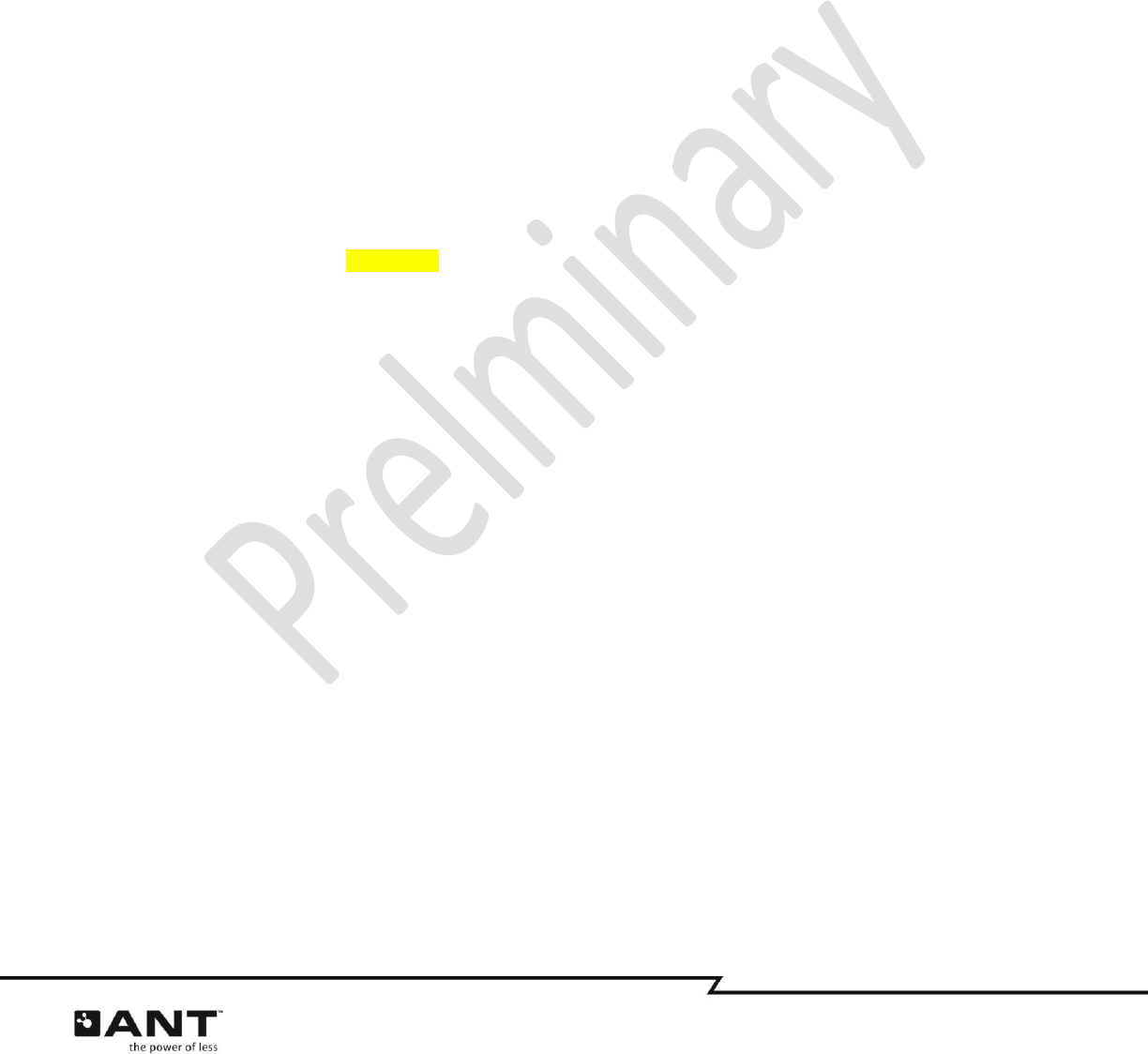
Page 10 of 14 ANTUSB-m Stick Datasheet
thisisant.com
EN301 489-1 v1.8.1: 2008 ERM; Electro Magnetic Compatibility (EMC); Standard for Radio Equipment
and Services
EN55022: 2006+A1:2007, Class B Information technology equipment - Radio disturbance
characteristics
EN61000-4-2:1995+A1: 1998+A2:2001 Electrostatic Discharge Immunity
EN61000-4-3: 2006+A1: 2008 Radiated Radio-Frequency Electromagnetic Field Immunity
2.4 Japan
The ANTUSB-m has been granted type certificate (certificate number 203-JN6016) in accordance with the
provisions of Article 38-24, Paragraph 1 of the Radio Law, in the classification of Article 2-1-19.
2.5 Australia & New Zealand
The ANTUSB-m has been tested and found to comply with AS/NZS 4268:2003, Radio equipment and systems –
Short range devices.
2.6 Russia
The ANTUSB-m has been tested and found to comply with Russian safety standards GOST-R.
2.7 China
The ANTUSB-m has been tested and received Type Approval Certificate from China for low power radio
transmission equipment. CMIIT ID: ….
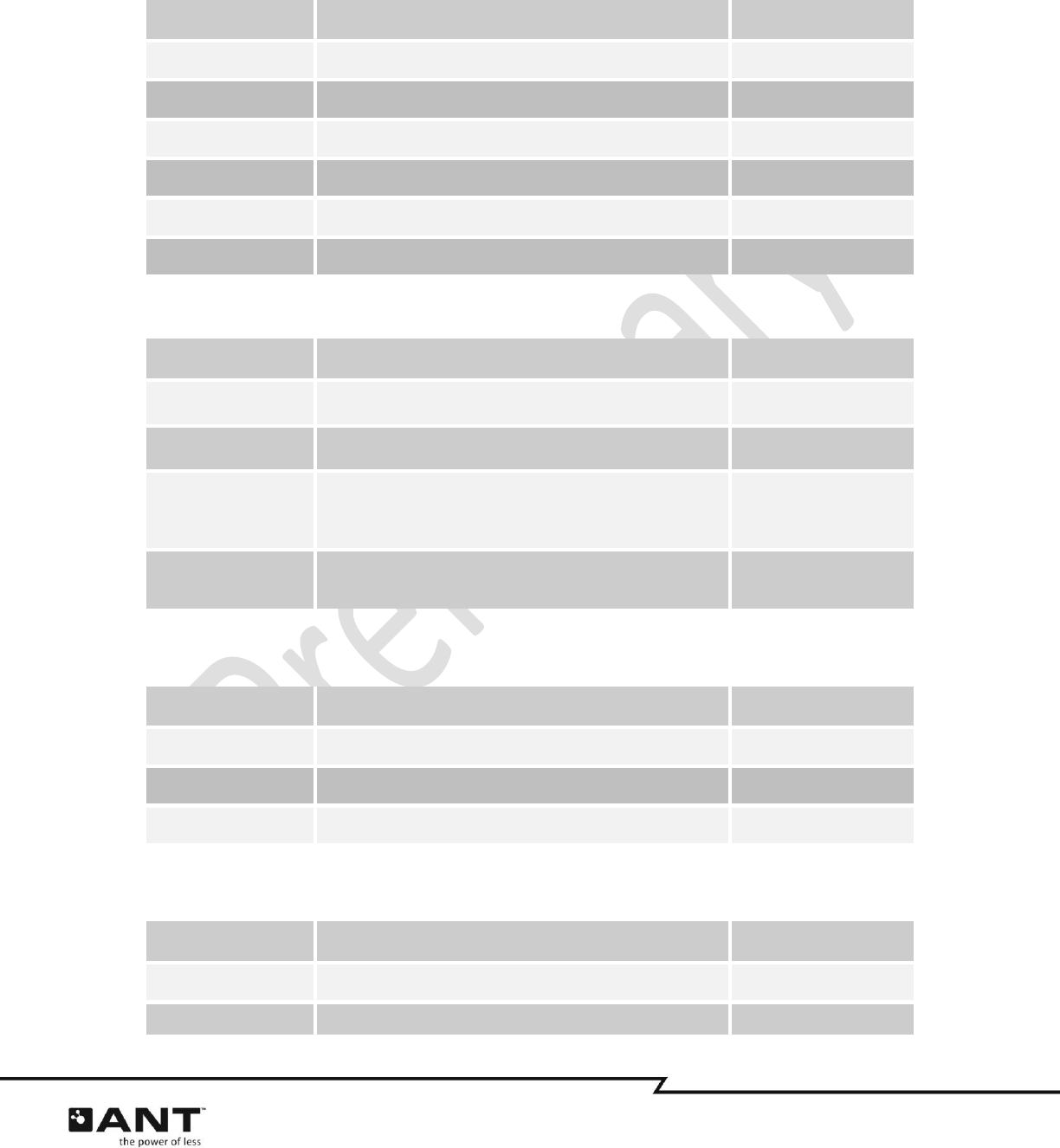
ANTUSB-m Stick Datasheet Page 11 of 14
thisisant.com
3. Specifications
3.1 Mechanical
Item
Specification
Notes
Full Product Size
L 19.0 ± 0.3mm x W 12.4 ± 0.3mm x H 5.3 ± 0.3mm
Product weight
<5g
USB Connector
Type A
Contact Durability
Rated for 400 insertions into USB port
Housing
PC/ABS plastic and stainless steel
Color
Black or White
3.2 Environmental
Item
Specification
Comments
Storage
temperature
-40°C to +70°C
Operational
temperature
-10°C to +50°C
Drop resistant
Survives with full functionality after 1 m on all 6 sides onto
concrete surface
Cosmetic damage may
occur.
Impact resistant
Survives impacts associated with typical PC Dongle – rough
usage
3.3 Electrical
Element
Specification
Comments
Operating Voltage
4.40V to 5.25V
Active Current
8.5mA to 13mA
Suspend Current
0.5mA
3.4 RF Communications
Element
Specification
Comments
RF Frequency Band
2403 – 2480 MHz
Peak TX Power
Maximum output power 4dBm
Typical 0dBm
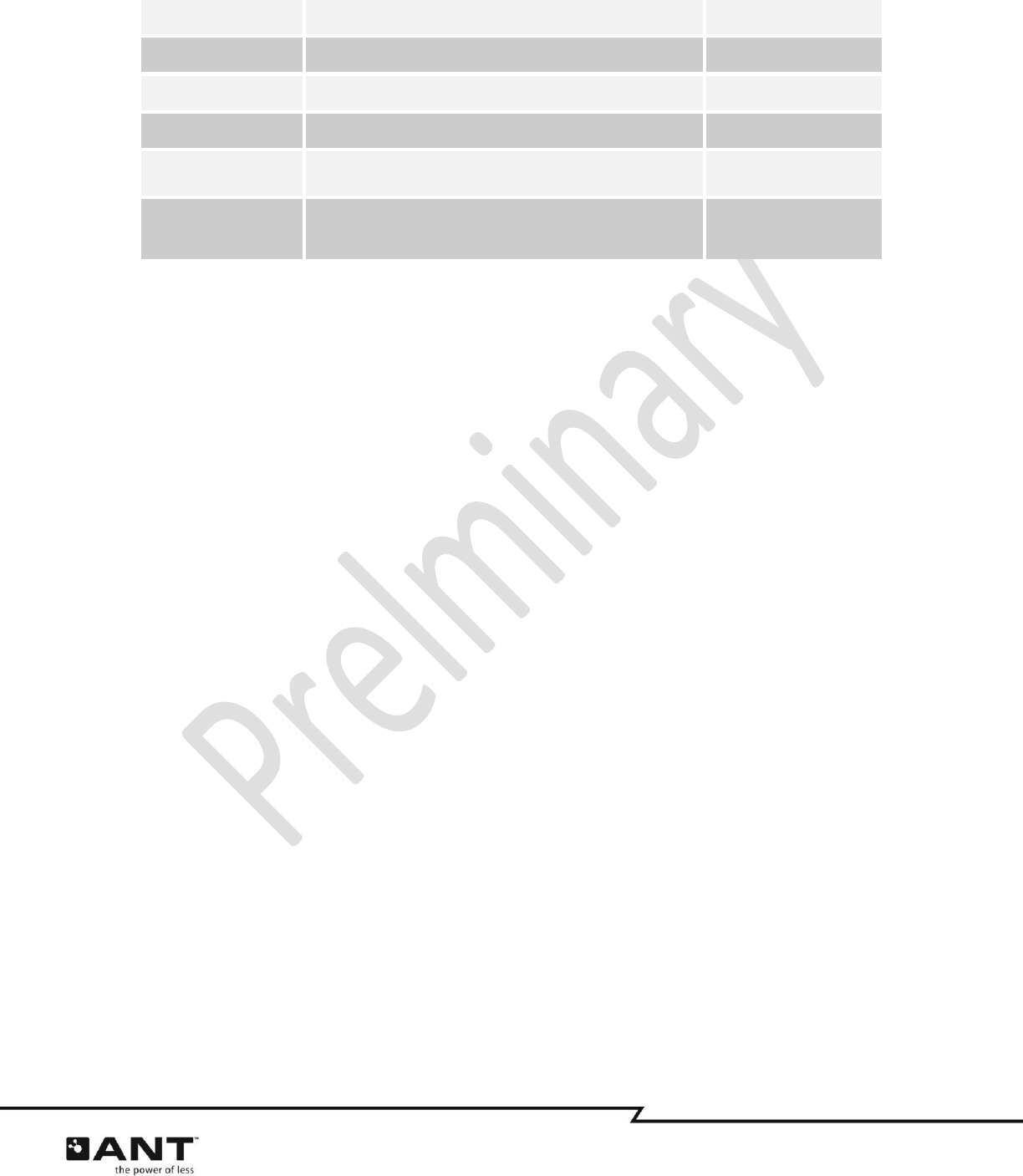
Page 12 of 14 ANTUSB-m Stick Datasheet
thisisant.com
Average EIRP
-3dBm +/-4dBm
Antenna Gain
0 – 2 dBi
Antenna Directivity
3dBi typical
Band Edge Power
-40dBm maximum (AU/NZ specification)
Harmonics Power
-40dBm maximum (AU/NZ specification)
Communication
Range
Typical 5-10m
Depending on specific
environment and
receivers.
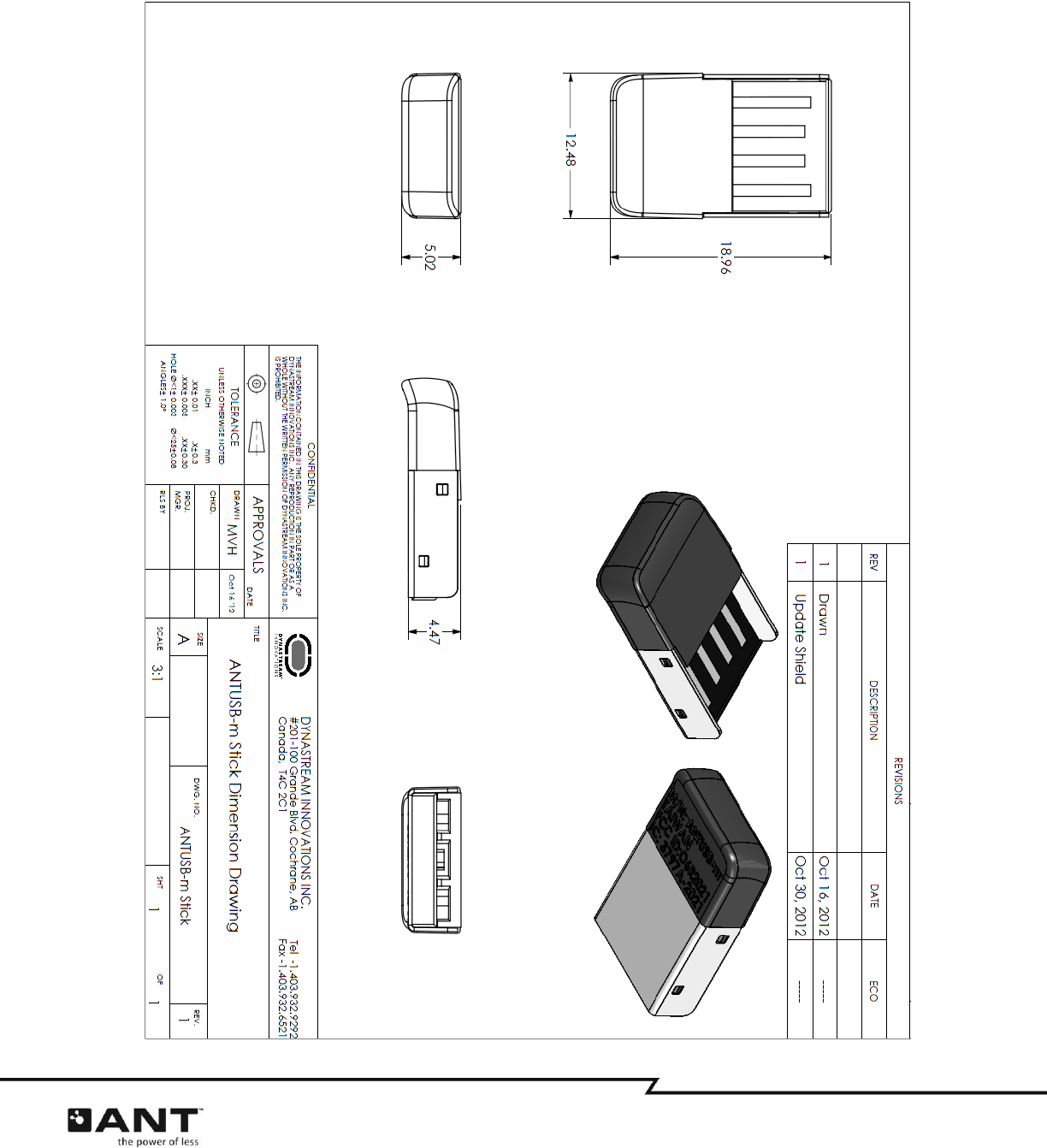
ANTUSB-m Stick Datasheet Page 13 of 14
thisisant.com
4. Mechanical Drawings
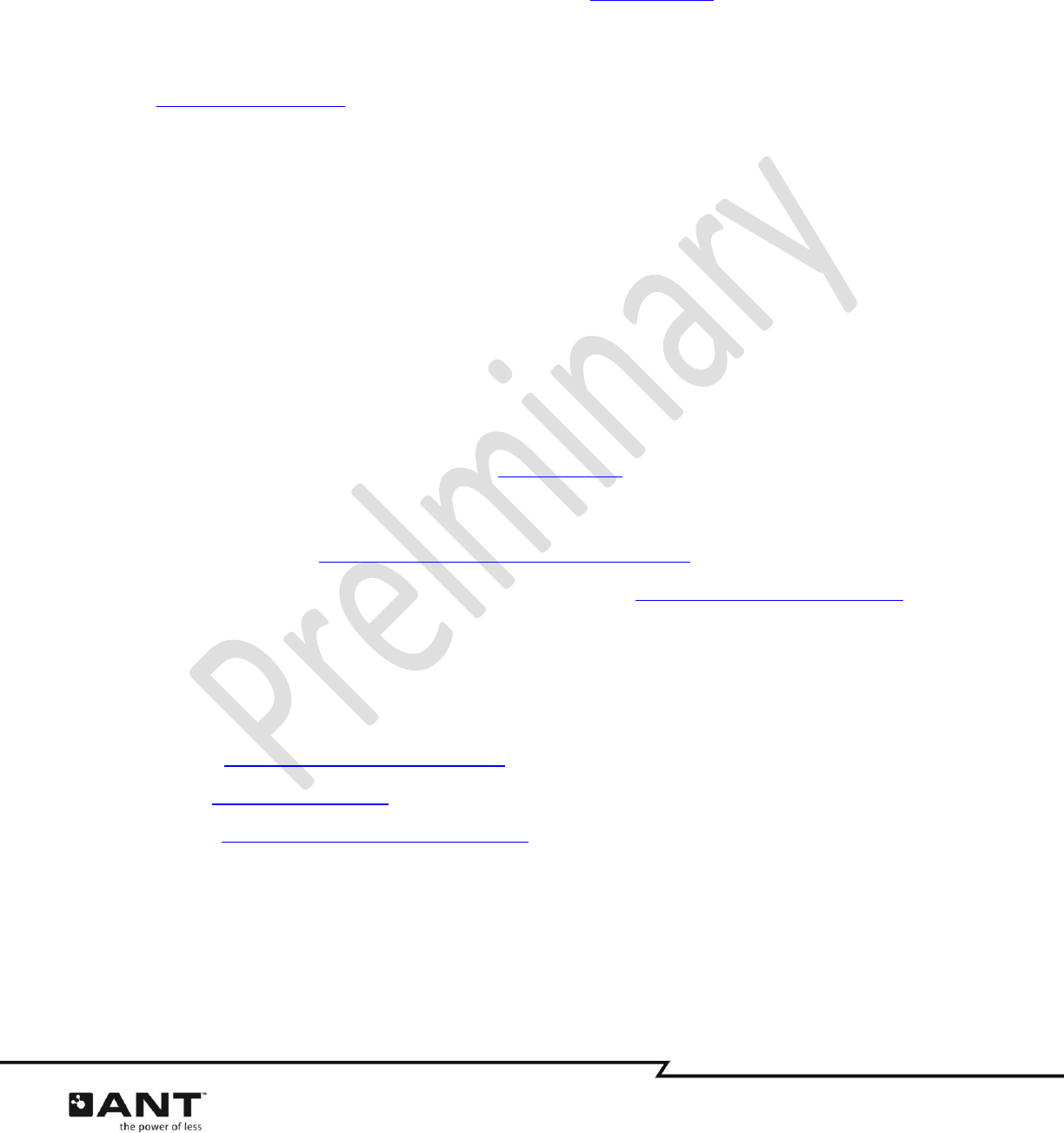
Page 14 of 14 ANTUSB-m Stick Datasheet
thisisant.com
5. Support
Users can seek application support from Dynastream Innovations, www.thisisant.com.
5.1 ANT Forum
Users are encouraged to participate in the ANT forum moderated by the application engineering team of
Dynastream Innovations for any engineering discussions. Joining the ANT forum is free and open at
www.thisisant.com/antforum.
5.2 Public Technical References
Documents:
1. ANT Message Protocol and Usage
Software:
2. Driver Windows XP, Vista, 7 and above
3. ANT library package for windows
4. ANT library package for Mac OS X
5. Android ANT SDK package
6. ANTwareII – a system testing and debugging tool
The above documents and software are available at www.thisisant.com
5.3 ANT Developer’s Zone
ANT development software tools, application notes, reference designs and other public resources are found in the
ANT developer’s zone at http://www.thisisant.com/pages/support/developer-zone.
To begin development with the ANT+ interoperability, please become an ANT+ Adopter or ANT+ Alliance member
to obtain the access to the ANT+ Adopter Zone. ANT+ documents and design tools contained in the ANT+
Adopter zone include the ANT+ Device Profiles, ANT-FS specification, ANT software (PC/Mac) libraries with source
code, and embedded reference designs with source code.
5.4 ANT Social Networks
ANT is on the following social networks,
YouTube: http://www.youtube.com/user/ANTAlliance
Twitter: http://twitter.com/ANTPlus
LinkedIn: http://www.linkedin.com/groups?gid=1379137